The Weekly Leading Index (WLI) of the Economic Cycle Research Institute (ECRI) is at 130.2, down slightly from last week's 131.0. The WLI annualized growth indicator (WLIg) dropped to 7.0% from 7.4% last week, an upward revision from 7.3%.
Last year ECRI switched focus to their version of the Big Four Economic Indicators that I routinely track. But when those failed last summer to "roll over" collectively (as ECRI claimed was happening), the company published a new set of indicators to support their recession call in a commentary entitled The U.S. Business Cycle in the Context of the Yo-Yo Years (PDF format). Late last month the company added its most recent publically available commentary on their website: Nominal GDP Growth Falls Again.
Essentially ECRI is sticking to its call that a recession began in mid-2012, although the company calls it a "mild" recession, which is quite a shift from their original stance 19 months ago: "...if you think this is a bad economy, you haven't seen anything yet."
ECRI posts its proprietary indicators on a one-week delayed basis to the general public, but last year the company switched its focus to a version of the Big Four Economic Indicators I've been tracking for the past year. In recent months, however, those indicators have slipped below the fold, replaced by the mixed bag of whatever Indicator du Jour might look recessionary, as in the "Yo-Yo Years" commentary linked above. Likewise, see this March 7th Bloomberg video. At about the 2-minute point Achuthan reasserts his call that a recession began in the middle of 2012. In previous interviews he has specifically mentioned July as the business cycle peak, thus putting us in the tenth month of a recession.
Here is a chart of ECRI's data that illustrates why the company's published proprietary indicator has little credibility as a recession indicator. It's the smoothed year-over-year percent change since 2000 of their weekly leading index. I've highlighted the 2011 date of ECRI's recession call and the hypothetical July business cycle peak, which the company claims was the start of a recession.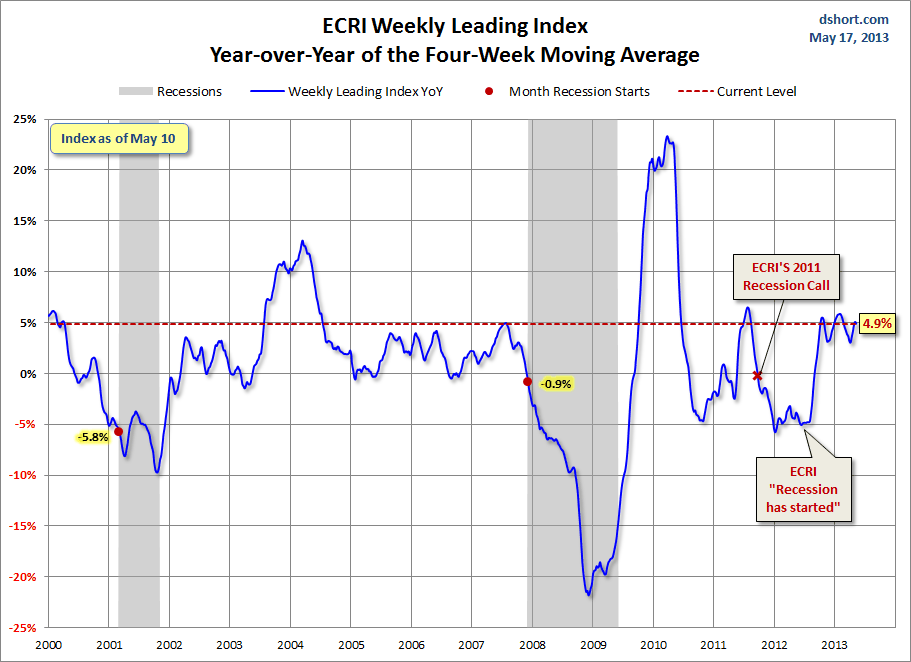
Here are two significant developments since ECRI's publick recession call on September 30, 2011:
- The S&P 500 is up 45.9%.
- The unemployment rate has dropped from 9.0% to 7.5%.
Ultimately my opinion remains unchanged: The ECRI's credibility depends on major downward revisions to the key economic indicators -- especially the July annual revisions to GDP -- that will be sufficient to validate their early recession call. Of course, the July revisions will be quite controversial this year, with some major accounting changes and revisions in annual GDP back to 1929 (more here). So if we don't get the downward revisions to support ECRI, they can always question the accounting changes in the revision process.
A Closer Look at ECRI's Latest Recession Evidence
Their latest recession evidence is the YoY growth in nominal GDP, which they highlight in this chart. 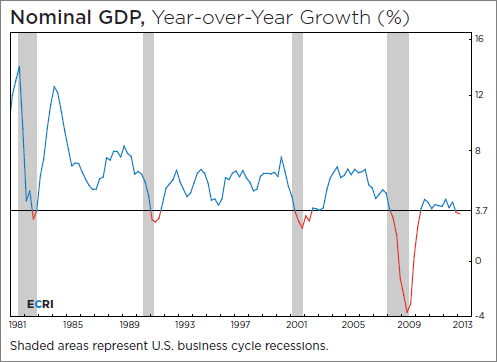
ECRI is absolutely correct in their observation that "yoy nominal GDP growth at or below 3.7% has been seen only in recessionary contexts. In Q1 2013, it fell to 3.4%, the second straight quarter below 3.7%."
For further support of their point, here is a snapshot of YoY Nominal GDP as far back as quarterly GDP has been calculated by the Commerce Department.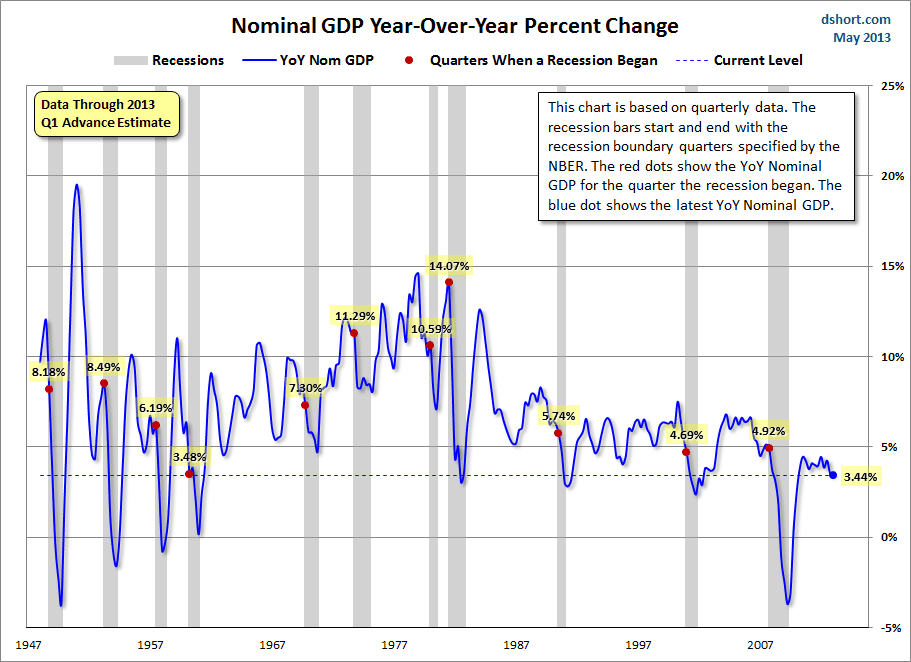
However, some might argue that the use of nominal GDP for a YoY analysis is problematic, especially to those of us who had 12% mortgages during that era of stagflation against the backdrop of a Fed Funds rate in the upper teens. Doesn't YoY real GDP have more credibility? Not surprisingly ECRI doesn't chart the the real YoY series, which has a couple of recessions that started with a lower YoY number than the latest data point.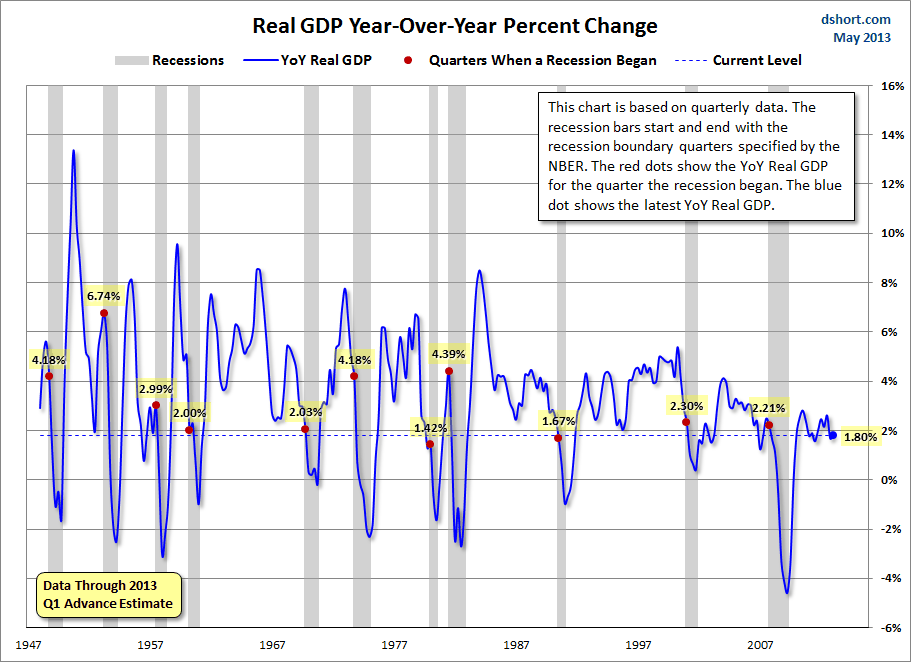
Actually, I think we could make a strong case for preferring the YoY behavior of real GDP per capita. After all, if we adjust for inflation, doesn't it also make sense to adjust this supreme economic indicator for population growth?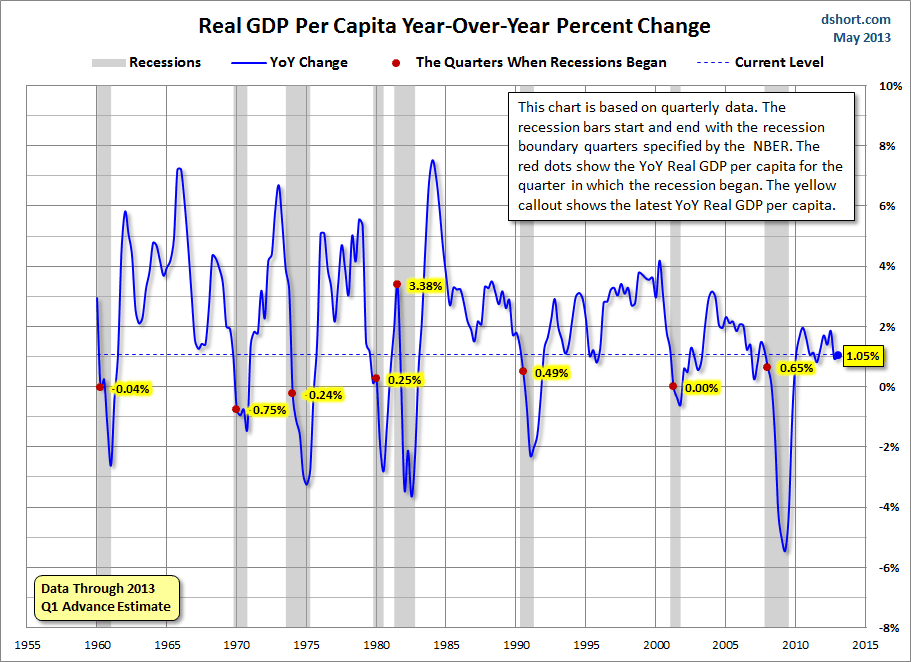
Oops! The current level of this version is higher than the onset of all recessions in this timeframe except for the second half of the early 1980s double-dip. This indicator would definitely not be of interest to ECRI.
ECRI's Recession Call Was a Bet Against the Fed
Let's briefly review the history of the ECRI recession call. ECRI adamantly denied that the sharp decline of their indicators in 2010 marked the beginning of a recession. But in 2011, when their proprietary indicators were at levels higher than 2010, they made their controversial recession call with stunning confidence bordering on arrogance:
Early last week [September 21, 2011], ECRI notified clients that the U.S. economy is indeed tipping into a new recession. And there's nothing that policy makers can do to head it off....
Here's what ECRI's recession call really says: if you think this is a bad economy, you haven't seen anything yet. And that has profound implications for both Main Street and Wall Street. (source)
Ironically enough, on the same day ECRI forecast a recession, Chairman Bernanke announced a new policy, Operation Twist, which was followed by QE3 in September 2012 and unlimited easing (aka QE4) in December 2012.
Essentially ECRI claim that "there's nothing that policy makers can do to head it [a recession] off" was a bet against the Fed.
For a few months after ECRI's recession call, their proprietary indicators cooperated with their forecast, but that has not been the case since the second half of 2012 -- hence their switch to the traditional Big Four recession indicators. Now that those are less cooperative, ECRI is cherry picking other indicators and switching to year-over-year perspectives when the monthly trend isn't sloping downward.
For alternatives to ECRI's recession forecasting, see method developed by Anton and Georg Vrba:
See also Dwaine Van Vuuren's latest RecessionALERT indicator snapshot:
Appendix: A Closer Look at the ECRI IndexDespite the increasing irrelevance of the ECRI's recession indicators in recent years, let's check them out. The first chart below shows the history of the Weekly Leading Index and highlights its current level.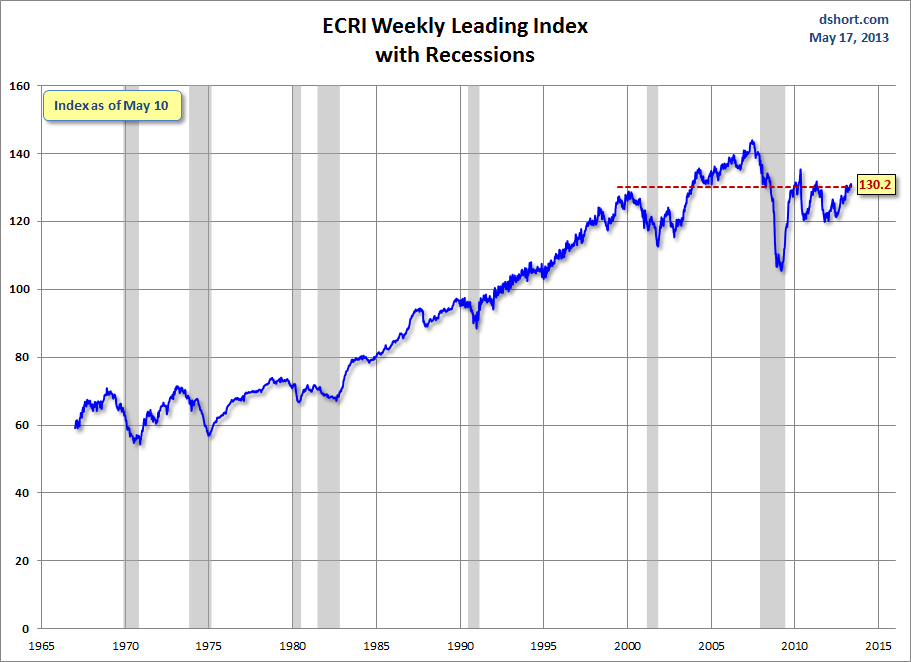
For a better understanding of the relationship of the WLI level to recessions, the next chart shows the data series in terms of the percent off the previous peak. In other words, a new weekly high registers at 100%, with subsequent declines plotted accordingly.
As the chart above illustrates, only once has a recession occurred without the index level achieving a new high -- the two recessions, commonly referred to as a "double-dip," in the early 1980s. Our current level is 11.9% off the most recent high, which was set over five years ago in June 2007. We're now tied with the previously longest stretch between highs, which was from February 1973 to April 1978. But the index level rose steadily from the trough at the end of the 1973-1975 recession to reach its new high in 1978. The pattern in ECRI's indictor is quite different, and this has no doubt been a key factor in their business cycle analysis.
The WLIg Metric
The best known of ECRI's indexes is their growth calculation on the WLI. For a close look at this index in recent months, here's a snapshot of the data since 2000.
Now let's step back and examine the complete series available to the public, which dates from 1967. ECRI's WLIg metric has had a respectable record for forecasting recessions and rebounds therefrom. The next chart shows the correlation between the WLI, GDP and recessions.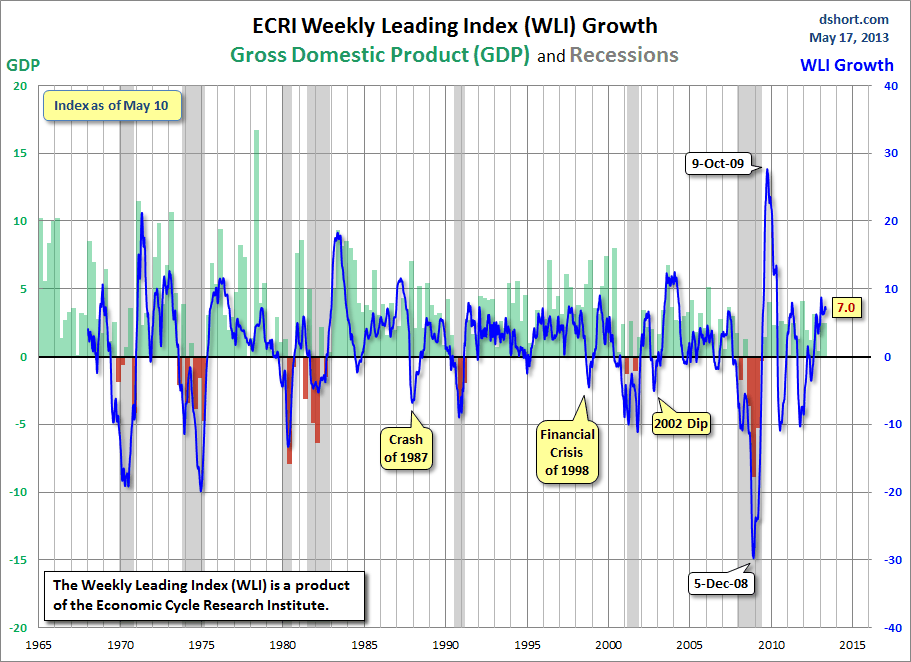
The History of ECRI's Latest Recession Call
ECRI's weekly leading index has become a major focus and source of controversy ever since September 30, 2011, when ECRI publicly announced that the U.S. is tipping into a recession, a call the Institute had announced to its private clients on September 21st. Here is an excerpt from the announcement:
Early last week, ECRI notified clients that the U.S. economy is indeed tipping into a new recession. And there's nothing that policy makers can do to head it off.
ECRI's recession call isn't based on just one or two leading indexes, but on dozens of specialized leading indexes, including the U.S. Long Leading Index, which was the first to turn down — before the Arab Spring and Japanese earthquake — to be followed by downturns in the Weekly Leading Index and other shorter-leading indexes. In fact, the most reliable forward-looking indicators are now collectively behaving as they did on the cusp of full-blown recessions, not "soft landings." (Read the report here.)
Year-over-Year Growth in the WLI
Triggered by another ECRI commentary, Why Our Recession Call Stands, I now include a snapshot of the year-over-year growth of the WLI rather than ECRI's previously favored method of calculating the WLIg series from the underlying WLI (see the endnote below). Specifically the chart immediately below is the year-over-year change in the 4-week moving average of the WLI. The red dots highlight the YoY value for the month when recessions began.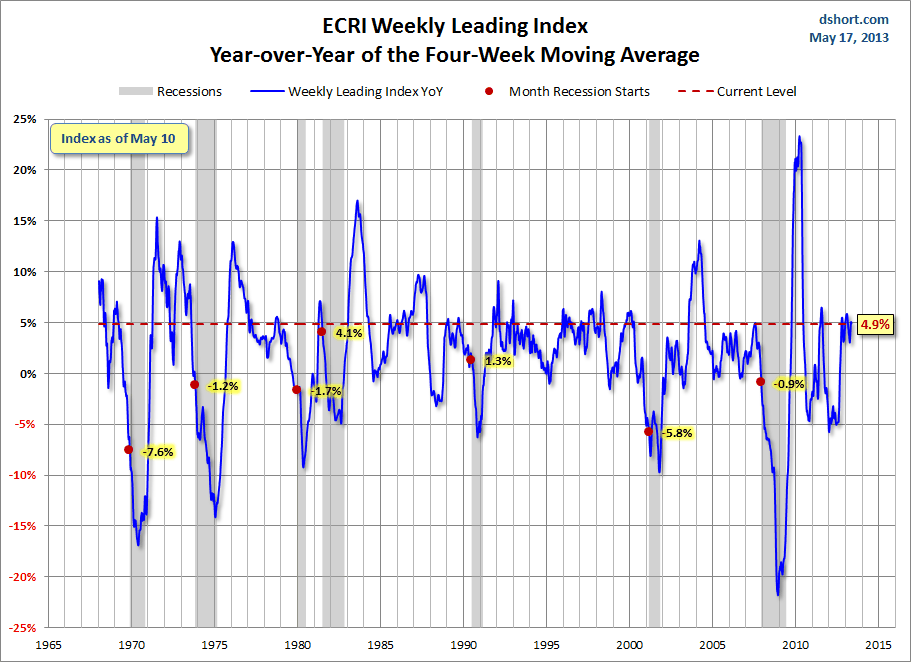
The WLI YoY, is off its interim high in early February. The latest reading is 4.9%, down from last week's 5.0%. However, this is higher than at the onset of all recessions in the chart timeframe. The second half of the early 1980s double dip, which was to some extent an engineered recession to break the back of inflation, is a conspicuous outlier in this series, and it started at a lower WLI YoY of 4.1%.
Additional Sources for Recession Forecasts
Dwaine van Vuuren, CEO of RecessionAlert.com, and his collaborators, including Georg Vrba and Franz Lischka, have developed a powerful recession forecasting methodology that shows promise of making forecasts with fewer false positives, which I take to include excessively long lead times, such as ECRI's September 2011 recession call.
Here is today's update of Georg Vrba's analysis, which is explained in more detail in this article. 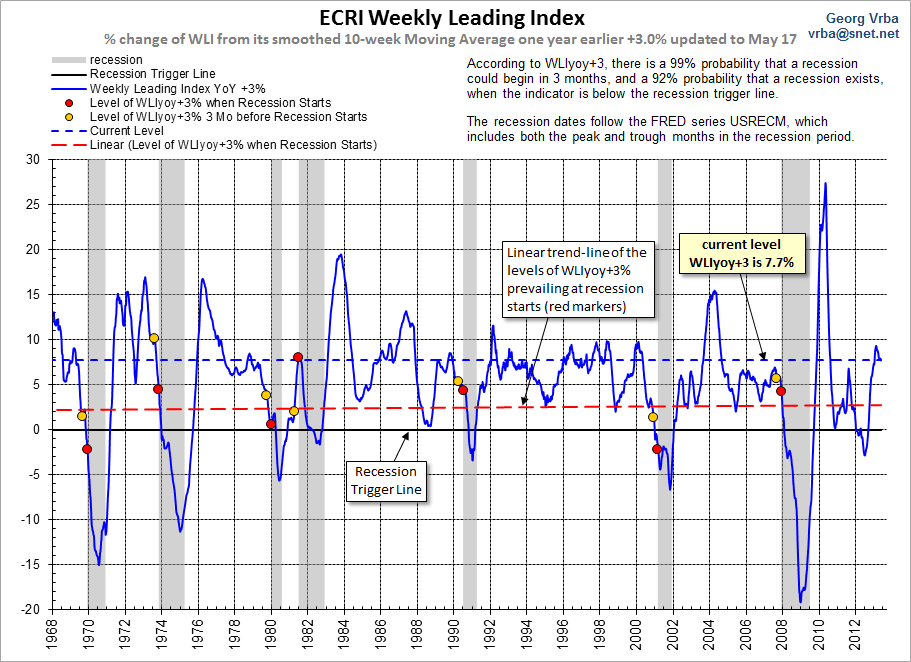
Earlier Video Chronology of ECRI's Recession Call
- September 30, 2011: Recession Is "Inescapable" (link)
- September 30, 2011: Tipping into a New Recession (link)
- February 24, 2012: GDP Data Signals U.S. Recession (link)
- May 9, 2012: Renewed U.S. Recession Call (link)
- July 10, 2012: "We're in Recession Already" (link)
- September 13, 2012: "U.S. Economy Is in a Recession" (link)
ECRI's weekly Excel spreadsheet includes the WLI and the Growth series, but the latter is a series of values without the underlying calculations. After a collaborative effort by Franz Lischka, Georg Vrba, Dwaine van Vuuren and Kishor Bhatia to model the calculation, Georg discovered the actual formula in a 1999 article published by Anirvan Banerji, the Chief Research Officer at ECRI: The three Ps: simple tools for monitoring economic cycles - pronounced, pervasive and persistent economic indicators.
Here is the formula:
"MA1" = 4 week moving average of the WLI
"MA2" = moving average of MA1 over the preceding 52 weeks
"n"= 52/26.5
"m"= 100
WLIg = [m*(MA1/MA2)^n] – m
